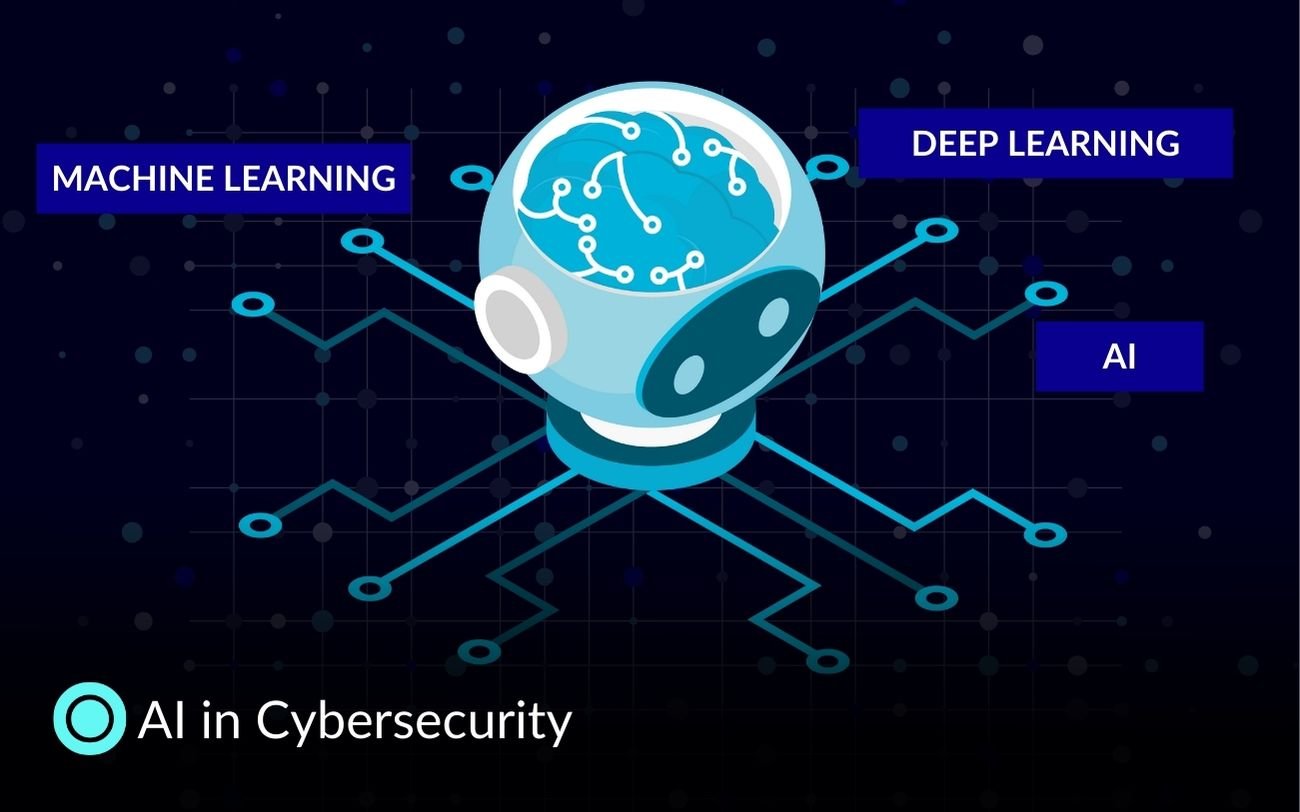Key Takeaways:
-
AI and cybersecurity are teaming up to make our digital defenses smarter and more effective against threats.
-
By automating routine tasks, AI allows security teams to tackle the bigger challenges.
-
Using AI in cybersecurity boosts efficiency, cuts costs, and makes protection strategies stronger.
-
As cyber threats change, AI is key in predicting and stopping potential risks.
-
Understanding how AI and cybersecurity work together is vital for keeping our digital world safe.
How Artificial Intelligence is changing the game in cybersecurity? It’s kind of like having a super-smart guard dog that never sleeps, always watching over your digital space.Why is this becoming a big deal?
The European Parliament pointed out that AI is popping up more and more in our cybersecurity systems. These systems are getting really good at spotting dangers, reacting quickly, and even predicting where trouble might come from next.
So, why is this important right now? Well, a 2023 report from eSentire, those experts in cybercrimes, tells us that hackers are getting craftier and their tools are getting sneakier. By 2025, we could see losses from cybercrimes hit an eye-watering $10.5 trillion.
That’s why boosting our digital defenses with AI isn’t just a smart move; it’s absolutely critical. It’s our best bet at standing strong against the bad guys using ransomware, cryptocurrency thefts, and other tricky tactics.
Featured Resource:
What is Cybersecurity? | Types and Threats Defined
Why AI in Cybersecurity is a Game Changer?
1- Catching Threats Faster and Smarter
Think of AI like your super sharp buddy who never misses a thing. It's really quick at picking up on threats that might take us forever to spot. Plus, it's pretty good at not getting worked up over small, harmless stuff.
Ever get annoyed by all those spam emails? AI is like a savvy gatekeeper for your inbox. It weeds out those sketchy emails and stops phishing attacks before they can bother you.Imagine having someone who knows exactly what junk mail to block.
2- Automating Cybersecurity? Yes, Please!
Absolutely! AI is like a whiz at doing all the repetitive stuff in cybersecurity, like detecting threats and sorting out incidents. This frees up the security team to dive into bigger and trickier challenges.
It’s like having a smart robot that takes care of all the mundane tasks. You’d have more time for the cool stuff, right? AI does that for cybersecurity teams it handles the day-to-day, letting the pros focus on big picture strategies and complex issues.
3- Making Things Run Smoother
AI doesn't just fight off threats; it also streamlines the whole security operation. By taking over the routine checks, it lets the human experts zero in on the more challenging issues that really need a personal touch.
Picture AI as a vigilant watcher over network traffic, flagging anything odd without ever taking a break. This means less time spent on the boring stuff and more on proactive security measures.
4- Saving Money Along the Way
And here’s a kicker: using AI not only ramps up security but also helps save some cash. By preventing breaches and cutting down the downtime that follows, AI reduces the costs tied to cyber incidents.
Companies that lean into AI for their cybersecurity often find they spend less money dealing with the aftermath of security breaches. It's like splurging a bit on a really good lock to avoid the much bigger cost of a break-in later.
So yeah, AI in cybersecurity? Total game changer. It’s like having that ultra-efficient buddy who not only keeps an eye out but also makes everything run smoother and saves you money. Want to dive deeper into how AI is transforming our approach to digital safety? Let's chat more about it!
The Cybersecurity of AI
While AI greatly enables us to combat cyber threats, at the same time it itself introduces unique security challenges that need to be catered to. Cybersecurity in AI deals with securing AI systems from various kinds of attacks that could compromise their functionality and reliability.
The major concern is data poisoning: attackers insert the malicious data into the training process, so further outcomes of functioning are incorrect or lead to harm.
A more serious threat is the adversarial attack, where inputs are manipulated in such a manner that an AI makes errors. In another cruel twist of its own, an AI model can also be stolen by hackers to carry out malicious use.
This security of AI systems definitely extends not only to the system itself but also to the data on which it operates and generates as breaches might have very negative consequences.
Ensuring the protection of AI systems will involve the development of sound data validation strategies, continuous monitoring for abnormal activities, and advanced encryption techniques in the protection of sensitive data.
Another important measure is to set a good regulatory framework ensuring the best practices possible in the development and deployment of AI in cybersecurity.
Featured Resource:
Fake News 3.0: The Era of Automated Fake Information
How is AI Used in Cybersecurity?
Behavioral Analysis and Threat Detection
AI has the capability to decipher patterns that may be posing as a potential threat by using large sums of data.
How?
It can collect users' behavioral tendencies to establish what is considered normal activity on a PC. It uses algorithms that analyze huge amounts of data—login times, IP addresses, and actions of a user. If anything is out of the ordinary—like an IP address the system doesn't recognize logging in at a peculiar time of day—the AI identifies that as suspicious.
Automated Response to Threats
The AI not only identifies threats; it also responds to them in real-time. It uses predefined rules and machine learning to decide on the best action to take when a threat is detected. For example,if AI identifies a potential hacking attempt, it could automatically restrict access or even shut off the affected part of the network while sending an alert to the security team.
Implementing AI in Cybersecurity: Making Things Safer Step by Step
1. Teaming Up AI with Current Security Tools
To get AI to help out with cybersecurity, you need to mix it smartly with the security stuff we already use. Think of it a bit like teaming up superheroes AI works alongside things like firewalls and intrusion systems. It's a little like having both a smart detective and tough bodyguard protecting your computer.
2. Training the Right People
For artificial intelligence to work effectively in protecting our computers, you need people who know their stuff about both AI and how to keep things safe online. It is equivalent to needing a pilot who can also fix the plane. This way, you're talking about jobs for folks who are data science whizzes, know tons about machines that learn on their own, and are sharp at spotting cyber tricks.
3. Keeping AI on Its Toes
With cyber threats evolving every day, AI needs to keep learning new tricks to stay one step ahead of the bad guys, always training with the latest info about threats just like your apps update on your phone. Now it's like teaching it new moves to be able to keep winning the game against the bad guys.
Rolling out AI in cybersecurity is hence not just a one-time setup and walk away; it's all about how it can be made to gel well with what is there, have the right heroes on the team, and be kept keen on the lookout, ready for anything. Ready to see how this can make the online world a safer place? Let's take a closer look together!
How can generative AI be used in cybersecurity?
Generative AI, a subset of AI that creates new content according to patterns in existing data, opens up tremendous potential in its applications in the area of cybersecurity.The main way generative AI is being used currently is through threat detection and management.
Generative AI finds patterns and anomalies that could signal a cyber threat from the analysis of vast data sources, including network logs, user behavior, and activities on the system. This manner of advanced analysis actually makes it possible for detecting both known and unknown threats quickly, thus reducing the dwell time in reacting to potential security incidents.
In this sense, generative AI would come quite handy in incident response and investigations. The AI can, upon security breach, automatically create the detailed reports and summaries of the incident for security teams to understand the nature and scope of the threat. This may involve human-readable explanations of complex security events, essential to convey information to non-technical stakeholders.
More than that, generative AI will help in an automatic response to certain types of threats, such as system isolation or blocking affected systems from carrying out malicious activities; this will allow security experts to turn more of their focus to the sophisticated tasks requiring human judgment and expertise.
This provides the capability for rapid detection, detailed analysis of a threat, and an appropriate response in an automated way, which is why generative AI is considered an important tool in ameliorating cyber defense.
What’s Ahead for AI in Cybersecurity?
Exciting Trends to Watch
Think of AI as that tech-savvy friend who’s always coming up with cool new tricks. Soon, it could be like having a pro hacker on your side, testing your defenses to make them stronger. That’s automated penetration testing — AI finding weak spots before the bad guys even have a chance.
And get this, some AI systems are gearing up to tackle attacks from all angles, almost like having a security guard with 360-degree vision.
Humans and AI: A Winning Combo
Even with AI stepping up, we still need the human touch. People are essential for solving complex issues and steering the ship with strategic decisions. Consider AI the ultimate wingman, boosting our security experts with super-fast insights that help them make smart moves quickly.
Here’s a real-life scenario: AI might spot something fishy in the data, but it’s up to a human analyst to weigh the findings and decide what to do. It’s like having a buddy who points out something off in the crowd you still need to figure out what action to take.
Playing by the Rules
As AI becomes a bigger player in cybersecurity, we’ve got to make sure it’s playing by the rules. Setting up clear guidelines is crucial to ensure AI is used responsibly. It’s about keeping AI’s actions transparent and accountable, much like making sure everyone knows the rules in a sports game.
It’s important for everyone to understand the moves AI is making, kind of like having clear rules and refs in a football match to keep things fair.
So, the future of AI in cybersecurity looks pretty exciting, doesn’t it? AI is getting smarter by the day, and paired with human expertise, it’s changing the game on how we keep our digital world secure. Keen to see how this partnership pans out? Let’s keep exploring and see where the tech takes us!
Conclusion
AI is transforming the cybersecurity landscape, offering powerful tools to detect, prevent, and respond to cyber threats more effectively. As both cybersecurity professionals and cybercriminals continue to leverage AI,it is crucial for organizations to stay informed about the latest developments and adopt AI responsibly to protect their digital assets.





